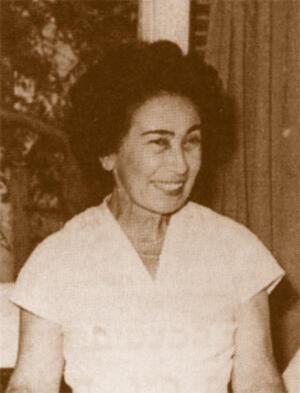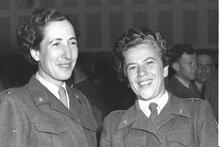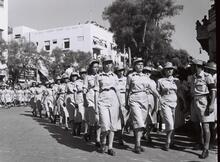Mina Ben-Zvi
Mina Ben-Zvi, the first commanding officer of the Israeli Defense Forces' Women's Corps, 1948. Source: The Haganah Archive, via Wikimedia Commons.
Mina Ben-Zvi’s life was defined by service in the name of the Zionist cause. Born Mina Rogozik in Russia in 1909, she moved with her family to Palestine in 1921. After completing her studies, she spent nearly a decade in the underground paramilitary organization Haganah, then became one of the first 66 women to enlist in the British Auxiliary Territorial Service during World War II. She served in Egypt as a commander. A few years after the war, she became the first commanding officer of the Israeli Defense Forces’ Women’s Corps, a role in which she negotiated the different expectations women faced in military service. After leaving the force, Ben-Zvi became a public figure and an advocate for women’s advancement worldwide.
Article
Born in Russia in 1909, Mina Rogozik arrived in Palestine together with her family in 1921. She studied at the Reali High School in Haifa and at New York University and joined the Haganah in 1933. In 1942, she was among the first 66 women to enlist in the ATS (Auxiliary Territorial Service) and served in Egypt as the commander (with the rank of captain) of a company comprising both Palestinian and British women.
In 1946 the Haganah sent her on a mission to the United States. In 1947 she was appointed head of the Histadrut’s Immigrant Absorption Department in the north of Israel and served in that position while she was asked to establish what became the IDF’s Women’s Corps, of which she became the first commanding officer in May 1948. During her two-year term of office, the complement of the Women’s Corps was established, determining that its members would fulfill the following functions: Static combat duties, defense of settlements, professional duties, administrative roles and auxiliary service (e.g., liaison personnel, drivers, cooks, nurses, policewomen, naval and air force ground personnel, draftswomen, manufacturing and quartermasters’ functions). Women were not permitted to undertake combat duties. Following the British model, and in accord with the objectives of the Women’s Corps, women were separated from men in the following areas: conscription, training, posting, camps and dormitories, medical clinics (including women medical supervisors), discipline and trials, equipment, promotion and culture. The Women’s Corps was charged with everything that related to servicewomen. In order to remove the women from the legal responsibility of the services and the Commands, OC Women’s Corps was accorded the rank of commander of a judicial district.
At the end of 1948, women began filling additional roles: in medical services, technological professions, transport maintenance, weapon maintenance and repair, and the repair and operation of means of communication. The Women’s Corps encountered innumerable problems, both internal and external, and Colonel Ben-Zvi insisted on the disbanding of the women’s companies in the Palmah. However, the Women’s Corps continued to function in similar manner until the reorganization of the IDF in 1949 at the end of the War of Independence.
Ben-Zvi joined her husband on a diplomatic mission to Finland from 1953 to 1955. She represented Israel on the UN Commission on the Status of Women (1956–1958) and traveled extensively in Africa and Asia in connection with the advancement of women. She was an active member of the Soroptimists, the International Council of Jewish Women and the Israel War Veterans League. Ben-Zvi was the first woman senior staff member of the Haifa Labor Council and a member of the Haifa City Council from 1959 to 1969. In 1961, she founded the Golda Meir Carmel International Training Center and was its director until 1987. She died in 2000.
Bloom, Anne. “Women in the Defense Forces.” In Calling the Equality Bluff: Women in Israel, edited by Barbara Swirski and Marilyn Safir, 138-138. New York: Pergamon Press, 1991.
“Mina Ben Zvi.” Mashav Carmel Training Center. Accessed July 21, 2020. https://mctc.mfa.gov.il/sites/default/files/mina_ben_zvi.pdf
Yuval-Davis, Nira. “Front and Rear: The Sexual Division of Labor in the Israeli Army.” Feminist Studies 11 (1985): 649-675.





